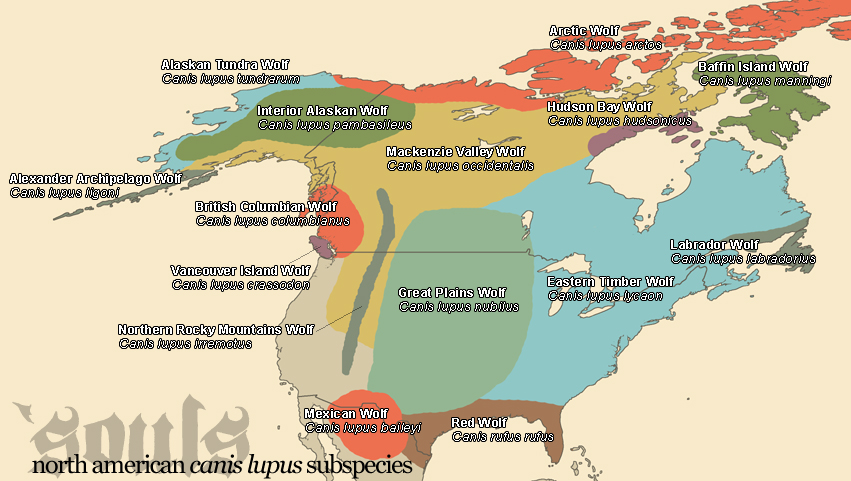Vancouver Island Wolf (''Canis lupus crassodon'')
See our RP Guide for more extensive information regarding wolves.
On this page... (hide)
- 1. Common Names
- 2. 'Souls Range
- 3. Appearance
- 4. Other Characteristics
- 4.1 Social Structure
- 4.2 Diet
- 4.3 Survival
- 4.4 Civilization
- 5. Citations
1. Common Names
Vancouver Island Wolf
2. 'Souls Range
Native to Vancouver Island, British Columbia, Canada. See the North American Subspecies Map.
3. Appearance
Canis lupus crassodon, from commons.wikimedia.org
The Vancouver Island Wolf is greyish-black or white in color; browns, tans, and other tawny colors are rare in this subspecies. It is a medium-sized subspecies, generally ranging from 26 - 32 inches (66 - 81 cm) in shoulder height, 4 - 5 feet (1.2 - 1.5 in length (including tail), with a weight range of 65 - 90 pounds (29 - 40.8 kg).
4. Other Characteristics
4.1 Social Structure
The Vancouver Island Wolf is extremely social, even for a Gray Wolf -- it prefers huge packs with an average of thirty-five members. As they are contained on Vancouver Island, they rarely interact with wolves of other subspecies; however, their range is shared by some coyotes.
4.2 Diet
The Vancouver Island Wolf's main food sources are the Columbian black-tailed deer and the Roosevelt elk. Thanks to the Vancouver Island Wolf's typical pack size, large prey is far easier to bring down than it would be for wolves who keep smaller packs. With thirty-five members to help hunt, even an adult male elk can be felled.
4.3 Survival
These Luperci were endemic to only one island, so of course, their population numbers were never large. In 1977, a population of 88 was enough to have this canine removed from the list of endangered species. Since the extinction of humanity, they have only further flourished.
4.4 Civilization
Despite the island nature of their home range, the Luperci virus spread readily through Vancouver Island Wolf populations -- likely due to their relative proximity to the ground zero of Lupercism in California. Despite this, they generally do have feral lifestyles -- humanized living is rare in this part of the world, and the Vancouver Island Wolves seem to prefer their former style of living, even if they do incorporate their other forms into daily life on occasion.
5. Citations


